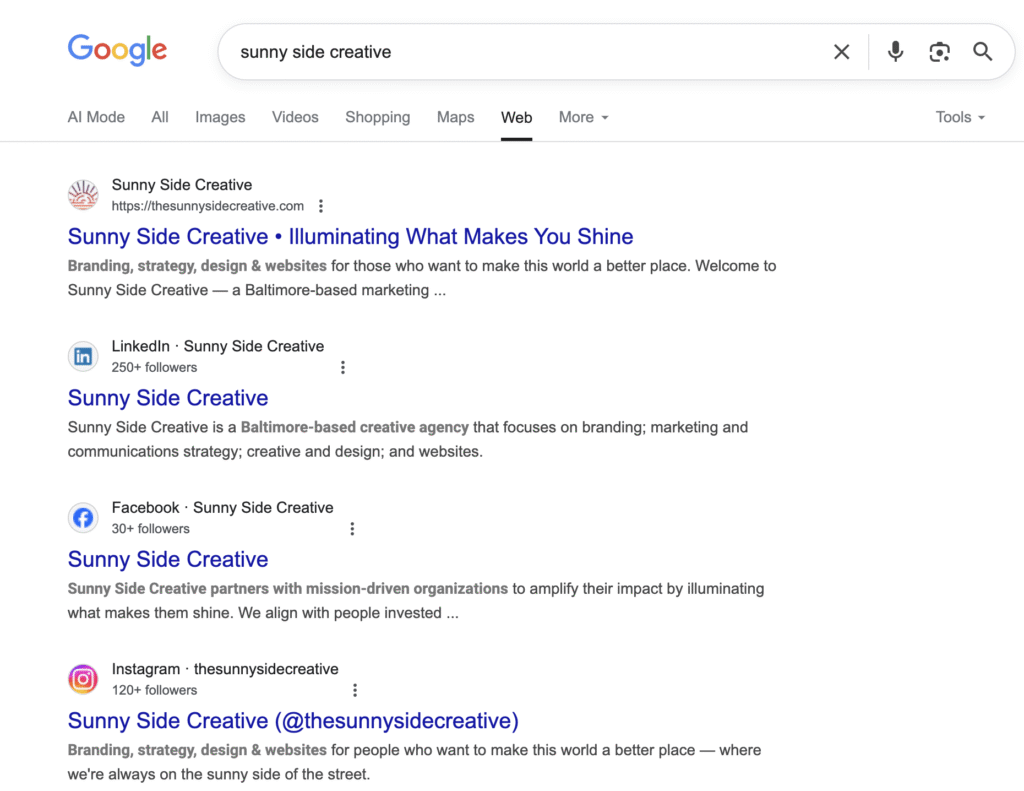Welcome back to our two-part series on SEO for nonprofit communicators! You’re an expert now on the technical definition of SEO and you have an idea of how it is activated. In this blog, we’ll dig into meta descriptions, backlinks, and Google tools that can help you maximize your SEO. (Missed Part I? Find it here.)
Meta Descriptions
A meta description is the summary that appears when a page is listed in search engine results. If the user finds the meta description valuable, they’re more likely to click on the link and follow it to your page. Since a meta description is one of the first things people tend to see when searching for something on a search engine, optimizing it is crucial for SEO. Put it this way: it’s your biggest chance to persuade users to click on you among the many results provided by a SERP.
If you don’t create your own meta description, search engines will simply pull the first 160 characters of the page. Depending on what the language contains, that can make or break your chance of someone clicking through to your site. For example, here’s what comes up for Sunny Side Creative:

Would you click on it? That’s what search engines are paying attention to — whether or not people would click on it. They use that information to decide where you should fall in the rankings on a SERP.
Backlinks
Receiving a link back to your website — a backlink — from an external website is like receiving a vote of confidence. This tells search engines that you are a reputable source — provided that the site linking back to yours is as well. There are two key ways to go about improving your backlink performance: guest authoring or being a source referenced in another site’s article.
For example, if your organization specializes in mental health and have a unique approach, write about that approach. Next, research organizations who are discussing different approaches to addressing mental health challenges. They might ask you to write something for their website directly or include a link to your article as part of their own.
To accomplish this, it does require some research and outreach to get your work in front of others. However, if you have the time available to commit, this can be a great way to enhance your organization’s credibility and reach!
Google Analytics
Google invests a ton into understanding why people make the choices they do and how those choices can be influenced. One such way this has manifested is through Google Analytics (GA4), which provides insights into how people interact with your website and ads.
Using GA4 can help you plan your time and budget accordingly. It can help you pinpoint what behaviors direct people to engage with your site and ads, as well as where people run into barriers. Information you can gain from Google Analytics includes:
- Overall website traffic
- Where your traffic is coming from
- Traffic on individual pages
- The number of converted leads
- Where your leads are coming from
- Demographics about your visitors (e.g. where they live)
- Whether your traffic is coming from mobile or desktop
Use these insights to help you refine and tweak your website and SEO strategy. For example, if certain ads are working to drive traffic to your site, replicate them or put more of your budget towards them. If users are hitting a wall on a certain page and bouncing off your website, use that information to rewrite that page. Google Analytics is an invaluable tool to keep in your SEO toolbox!
Google Ads
As with any marketing strategy, the primary objective is to understand what content people will find valuable. The way it’s deployed in Google Ads is by identifying the search terms that lead people to your content and using ads to respond to those search queries.
It uses a pay-per-click (PPC) model to get your ad in front of your target audience — ie. when someone clicks, you pay. You can set your budget and determine how much you’re willing to pay per click, making it a cost-effective way to promote your organization. Also, there’s a grant that offers up to $10,000 a month toward ads — we have a whole separate blog on that topic!
Google Reviews
And now for one that requires the least legwork from you: Google Reviews! User-generated reviews often include descriptions of programs and services, which unintentionally provide deeper content about your organization. And the more content available, the more a search engine can “read” to understand what you do and identify new keywords — which drives traffic, increases SEO value, and enhances your site’s visibility.
So when possible, encourage your constituents to leave a Google Review — it just might be the deciding factor that helps someone commit to your organization!
We recognize that this is just the tip of the iceberg when it comes to SEO — and that there are thousands of blogs, podcasts, and videos dedicated to this very topic. If you don’t have the time to delve deep, lean on us for help! We can support you in developing an SEO strategy; incorporating it into an overall marketing strategy; crafting optimized blog content and web copy; or identifying a partner to activate the Google Ad grant.
However you need support, we’d love to hear from you!



